| 1 | Britain’s most common snake |
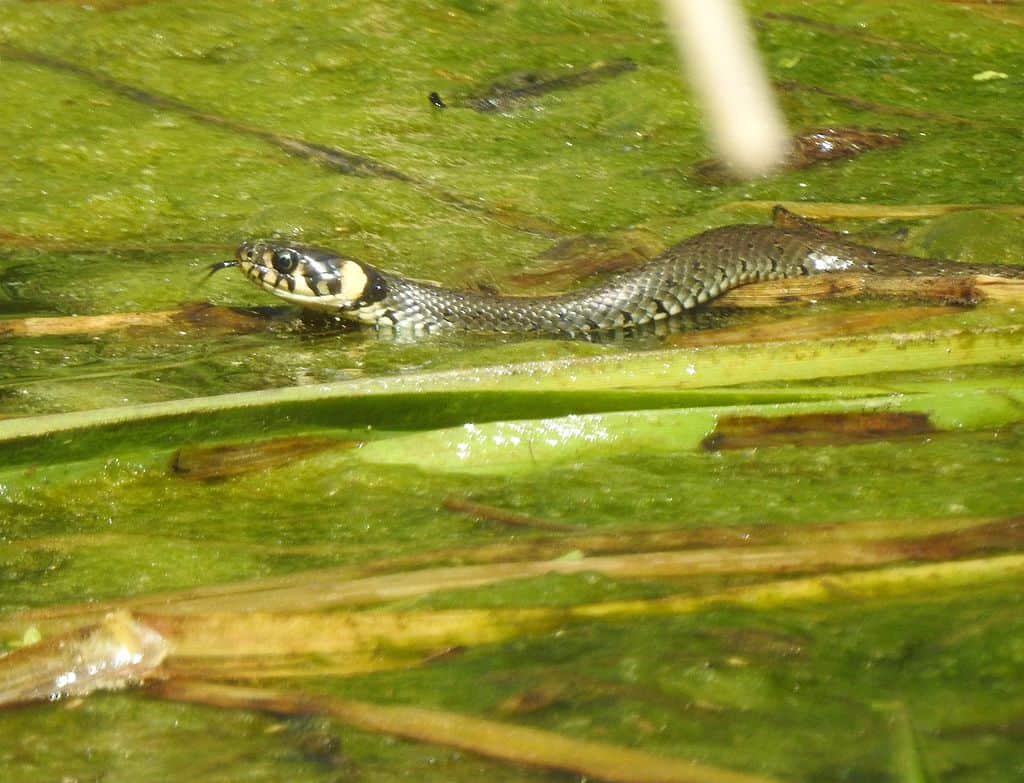
Ignoring the occasional boa constrictor that escapes from its owner and spends a relaxing few days exploring the countryside, the British Isles are home to only three species of snake. The first is the endangered smooth snake, which dwells mainly in sandy heaths. The second is the widely feared adder, which has a venomous bite capable of causing severe swelling.
The final, and most common species in Great Britain is the grass snake (Natrix natrix). This species is found primarily in southern and middle England. It also exists in Wales and and the windswept northern reaches of England, and very occasionally crosses the border into cooler Scotland.
Like other snakes, it’s incapable of generating its own body heat, but the grass snake still holds the title of one of the most northerly-dwelling snake species in the world. The secret lies with its breeding, in its tendency to lay eggs in dung heaps or compost piles, which are warm all year round. They also play the odds by laying a high number of eggs, usually 10-40 (which have a leathery texture).
This dung heap method is so important to grass snakes that according to historians, their numbers rocketed upwards after the dawn of agriculture 6000 years ago. Their wider range includes all of Europe except for Scandinavia, and stretches eastwards all the way into Mongolia.
| 2 | Most common near water |
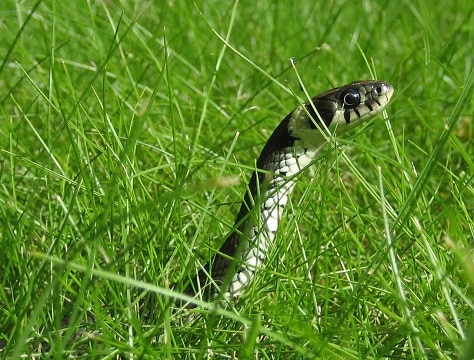
The grass snake has a boring reputation in Britain. It’s green, and it slithers though grass – so what? However, the species is known for its immense swimming capabilities. Its name is misleading, as the grass snake only spends the majority of its time in grass from July onwards when its hunger massively increases and its aggression levels follow. For the rest of the year, its natural abodes are wetland habitats like ponds and lakesides. These are by far the most common places to spot them, usually after being disturbed from their lurking spots by unsuspecting dog walkers.
Their swimming is far from a sluggish, lazy float either; this youtube video shows a grass snake swimming in the New Forest with all the focus and determination of a speedboat. They’re nimble and surprisingly skilled at turning corners, and surprisingly fast given that their swimming motion is powered completely by slithering and writhing.
Consequently, one of the grass snake’s many names is the water snake (with ringed snake being another). In spring and early summer, they also like to float on lily pads in order to ambush newts, like a scene from a fairytale.
| 3 | Incapable of hurting humans |
In all the dog walkers or nature enthusiasts sitting by a pond staring at tadpoles over the years, there has never once been a fatal case of grass snake bite. The species has no power to kill humans, even in the flukiest of circumstances. The adder caused a well-publicised death back in 1975 (in Trossachs, Scotland), but the adder has venomous fangs, while the grass snake produces no venom.
In fact, the grass snake has no teeth at all, and is notable only for its extreme timidity in the heat of battle, a battle which usually doesn’t start. Instead of springing forward, the grass snake has a much cooler tactic – straightening its upper body and flattening its head and neck to resemble a cobra.
For years, this left biologists dazed and confused, seeing as the mighty cobra family lives far away in Asia and Africa. The two species don’t overlap in their ranges, but then the scientists remembered a discovery in 1933, the fossils of an ancient European cobra called Naja romania. This species is long gone, yet a fragment of its memory survives in the grass snake’s defensive tactics, which probably evolved to resemble its more fearsome rival snake and scare any predators senseless.
| 4 | ID signs: the creamy neck band |
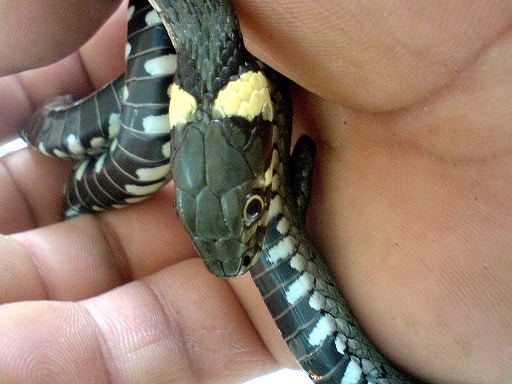
The colouring varies wildly with grass snakes, but as you’d expect, the patterns are optimised to help them slither though grass undetected. Your average grass snake has olive-green or olive-brown scales, interspersed with thinner lines of parallel black scales, with some black markings being further spaced out in islands. In some places, the colouring closely resembles a twister ice lolly.
There are also black patches descending from the eyes like a black tear stain, but the grass snake’s most distinctive feature by far is the yellow-black collar around its neck. Only the n. astreptophorous subspecies of the Iberian peninsula and Jersey lacks this collar.
Like the ghostly spirit bears of Yukon, or the orange cave crocodiles of Gabon, grass snakes occasionally have some unusual colour morphs. In the UK, there has been 9 records of melanistic grass snakes, unusually black versions with all the darkness of night, caused by a genetic over-accumulation of melanin. All but one were found in southern England, with the last being found in Derbyshire. The main way to differentiate between adders and grass snakes is the former’s clear zigzag patterns, but once in a blue moon, a grass snake with those patterns will be spotted as well.
| 5 | An expert death-faker |
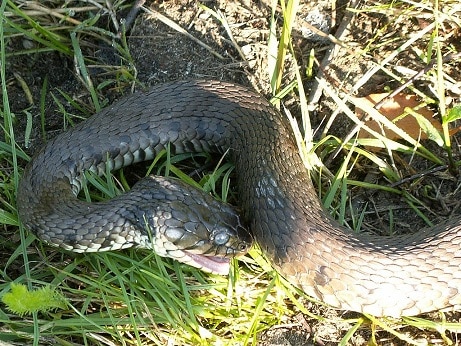
Every species has a secret weapon, but the grass snake’s is particularly hard to detect. When confronted by terror in the form of a bird or fox, the grass snake will emit a foul-smelling odour, which is widely said to have a garlic flavour. Its goal is to scare the predator away, but if this first move fails, then the grass snake will roll onto its back. It will leaves its mouth hanging wide open, loll its tongue down, and curl its body into an unnatural position, all with the goal of playing dead. If the predator walks away, then the snake will steadily uncoil itself, sometimes beginning the process with a wag of the tongue.
This skill comes with experience, as one study found that hatchlings rarely use the play dead trick, compared to adults who used it during 66% of predator assaults. It seems that young grass snakes aren’t aware of how convincing their acting is, until they try it several times and have the success programmed into their natural day to day instincts. This play dead act is known as thanatosis.
There’s only one downside to this scheme – tying themselves in a knot! During its limpness, the grass snake will sometimes cross its body over by accident, forming knots that would have a fisherman cursing his useless hands for hours. Luckily, this rarely causes problems, as they seem to have the natural instincts to untie themselves rapidly.
| 6 | Diet: mainly frogs and toads |
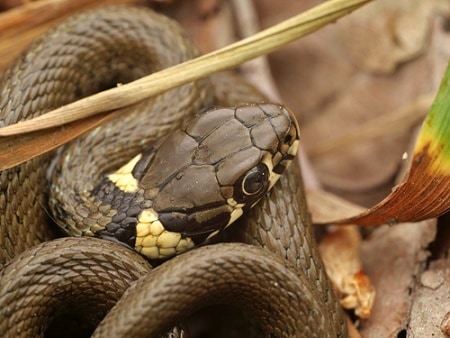
Grass snakes are creatures of the water, and almost all water-based creatures are fair game as long as the creature is small enough to physically fit inside its stomach. Grass snakes enter hibernation in late October or early November, and when they emerge in March, the first food their eyes turn to is fish. Spring is the spawning period of small, flapping fish and through to late May, the grass snake will spend its days silently stalking them through the tall green reeds and damp vegetation. In late May, the newt brigade suddenly arrives in force, including the UK’s great crested newt species.
The grass snake’s diet is perfectly attuned to the life cycles of other creatures. For example, the newt rarely leaves its watery dens until mid-July, but toads and frogs usually move to dry terrain in mid-April.
Consequently, a grass snake doesn’t get the chance to eat frogs and toads until mid-July, when it also moves to dry lands. This is the time of year when you might see grass snakes slithering through damp woodland paths, a time when their staples expand to mice and voles scurrying unseen through the grass. Occasionally, grass snakes will slither up a tree and pinch chicks from the nests of mother birds.
| 7 | May drop from the sky |
Water they might love, but nowhere is truly immune to the menace of grass snakes. Case in point: the Hartshole Country Park of Lincolnshire, located in the mid-east of England.
On June 16th 2020, 75 year old Christ Tredwell was walking through this green and vibrant park when he noticed a black crow flying overhead with what appeared to be a twig. Nothing seemed to be out of the ordinary, but seconds later, Tredwell’s heart fluttered as a 1 metre long grass snake almost landed on his head.
Tredwell edged forward, and quickly snapped a photo with his smartphone which just captured the front of his curious dog’s head. When the snake moved slightly, the dog instantly recoiled. The crow had evidently become overambitious with its prey and decided that the snake was too heavy to carry off. The snake had missed Tredwell’s head by mere inches. For a moment, Tredwell feared that it was an adder but breathed a sigh of relief when he saw the grass snake’s telltale green-yellow colouring. “I just wish I’d had my phone ready to take a picture of it in mid-air” he said.
| 8 | Surprisingly long |
With few exceptions, a female grass snake is far larger than a male. The female range is approximately 75-90cm, while male snakes average at only 60cm. But the largest grass snake ever measured was 1.8 metres, a green-yellow snake ripped straight from the pages of fairytales. After birth, the species measures 14.8-15cm, and by the conclusion of year 1, the average grass snake will be 21-22cm. It’s believed that males reach sexual maturity before reaching 30cm in length.
Another difference between the sexes is that female grass snakes shed their skin just once per year, while males grass snakes shed their skin twice. One of the sheddings takes place after emerging from hibernation in March. Like many reptiles (and dragons according to some reports), grass snakes get longer and longer each year, growing continuously as they guzzle down more and more tadpoles and newts. Grass snakes are truly limitless, except maybe when they get stepped on. The lifespan of the species averages at ten years, but it’s possible for rare grass snakes to rule over their local pond for 25 years.
| 9 | Crazy folklore surrounds them |
It’s widely believed that a grass snake cult existed in Pagan Europe, before Christianity moved in around 2000 years ago and branded most snakes as a symbol of evil. But in the Baltic region, many of those beliefs survived well into the early 20th century. The Lithuanians believed that an injured grass snake would take revenge on the perpetrator, commonly by injuring cattle or poisoning the household supply of milk. Cattle and milk are the cornerstones of many stories, as other Lithuanian households would leave a bowl of milk as an offering, despite grass snakes having never been observed to drink milk. Thereafter, the snakes were said to protect the farmer’s cattle as they dwelt in the warm compost heaps nearby.
Other stories involve grass snakes eating at the dinnertable, or slithering into children’s bedrooms for protection. Ancient Baltic societies believed that a grass snake protector lived under every household and that should it ever leave, the house would inevitably burn down.
In mid-summer, the grass snakes would supposedly come together for weddings. Some of the males would fail to find a mate, but not be bitter in the slightest, and instead form a protective circle around the marrying couples using their defensive stink to ward off predators. In Latvia, a common folk saying is “who kills a grass snake, kills his happiness”.
| 10 | The British version is unique |
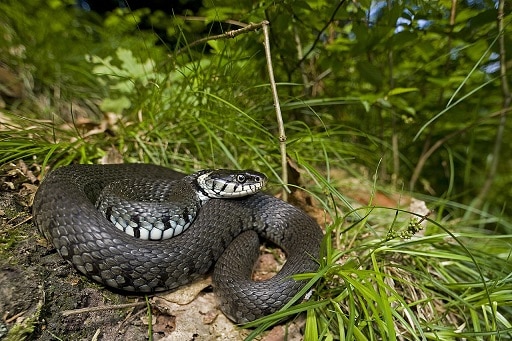
As nondescript as grass snakes may seem, scientists are making new discoveries about them all the time, and one announced in 2017 was a biggie.
In the UK, locals had long been snapping pictures of grass snakes with a significantly higher amount of black scales than usual. Rather than thin lines, these scales were as dark as night and clearly contrasted with the normal green scales. These specimens were dubbed the barred grass snake, or natrix natrix helvetica, and were originally said to be a mere subspecies of the wider grass snake species (natrix natrix).
But in 2017, after analysing 1600 grass snake specimens from across Europe, a team of scientists made an shocking conclusion: the UK version was distinct enough to be its own species altogether. There was a clear genetic line east of the Rhine River in Germany, which comprised the original grass snakes, and another genetic island to the west, which had now become the barred grass snake. The scientists chopped the second natrix off the Latin name, and the barred grass snake officially became known as natrix helvetica.
Contrary to media reports, these snakes still had the traditional black collar. Others have claimed that the UK now has 4 snake species, but in reality there’s still 3, as all British grass snakes have been recategorised as the barred grass snake.
